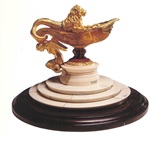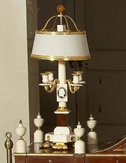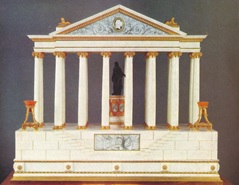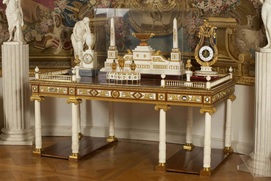Articles of ivory and amber
Noteworthy among the rich and elegant embellishments of the Palace rooms are various objects of ivory and amber. No other museum or palace in Russia can rival the Pavlovsk collection. The objects of ivory and amber always evoke a vivid interest in visitors to the Palace due to their graceful forms and unusual material; these include table decorations in the shape of austere classical temples, colonnades and obelisks, elaborate ancient Roman lamps, tables, writing appliances imitating antique forms and many other decorative objects.
Ivory and amber were used not only for various small-scale table decorations, but also for the trimming of bureaux and fire-screens. Ivory produces, in combination with mahogany, a brilliant decorative effect. Of particular note is a large desk made for Grand Duke Paul in 1794. It is a veritable work of architecture with its colonnade of carved ivory used to support the top designed as a small bureau resting on an ivory portico temple. A writing set made of amber and ivory candelabra add a sense of unity to this brilliant piece executed in the workshop of Gambs according to Brenna's design. Some surviving Brenna's drawings fr om the period when the desk was designed, confirm his authorship.
There is another, even more luxurious mahogany desk, which was designed by Brenna in collaboration with his assistant Rossi and produced by Gambs for the Study of Paul I in the Mikhailovsky Palace in St Petersburg about 1800. This desk was adorned, alongside traditional chased ormolu and ivory, with copies of antique cameos set into an architectural decor. Cameos were also used for an excellent writing set and two candelabra decorating the desk. Pieces of furniture adorned with carved ivory were produced by skilful cabinet-makers and bronzeworkers. Many beautiful ivories for the Pavlovsk Palace were turned by Nikolas Vaye. Designs for them were usually made by eminent architects. The Palace's archive preserves a large collection of such drawings by the architect Rossi.
Articles of ivory had been popular in Russia since long ago. In the seventeenth century, talented carvers fr om the Arkhangelsk province in the north of European Russia were invited to the Tsar's court to make all kinds of ivory objects. Peter the Great himself took an interest in ivory carving. He liked to spend his time in his workshop, one of the best in Europe, wh ere he made quite sophisticated pieces of ivory, including even chandeliers. He was aided in his work by Andrei Nartov, a skilled master and mechanic who invented the lathes used in the workshop.
In the eighteenth and early nineteenth centuries master carvers from the village of Kholmogory near Arkhangelsk (wh ere the celebrated scientist and poet Mikhail Lomonosov was born and grew up) made of walrus and mammoth tusk delicate caskets and boxes and various toilet accessories notable for their perfect finish and elaborate openwork carving. Reproduced in this book is a surviving carved plaque from an ivory casket made in the early nineteenth century by the master carver Nikolai Vereshchagin from Arkhangelsk. The Russian North was rich in talented craftsmen who produced dozens of fascinating ivory objects, which now occupy pride of place in many large Russian museums.




